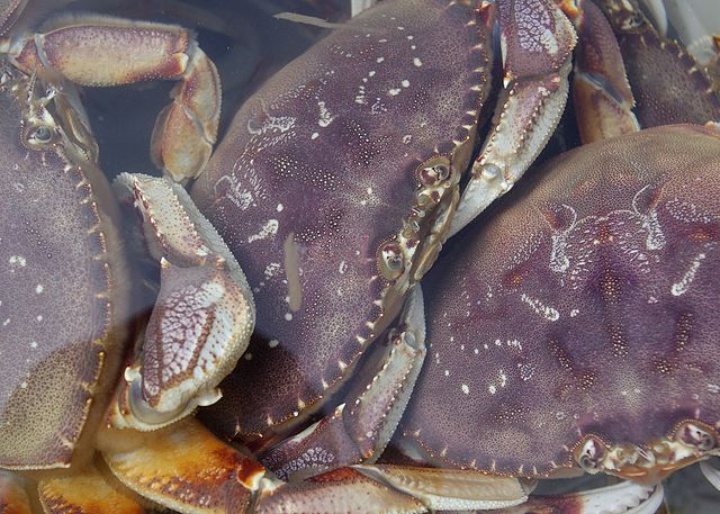
Wikimedia.
California Department of Public Health press release:
SACRAMENTO – The health advisory has been lifted for Dungeness crabs caught in state waters in all areas south of Latitude 38° 57.5’ N (near Point Arena), and north of Latitude 40° 01’ N (near Shelter Cove).
The California Department of Public Health (CDPH) lifted this advisory today due to recent tests showing that traces of domoic acid have declined to low or undetectable levels in Dungeness crabs caught in the area, indicating that they are safe to consume.
This partial lifting comes after the December 1 announcement lifting the advisory for Dungeness crabs caught in state waters south of Latitude 38°34.5’ N near Salt Point, and north of Latitude 40° 46.15’ N near the North Jetty to Humboldt Bay.
The advisory remains in effect for Dungeness crabs caught in state waters north of Latitude 38° 57.5’ N (near Point Arena) and south of Latitude 40° 01’ N (near Shelter Cove).
CDPH and the Office of Environmental Health Hazard Assessment agree that Dungeness crabs caught in the areas south of Latitude 38° 57.5’ N, and north of Latitude 40° 01’ N are safe to consume.
However, as a precaution, consumers are advised not eat the viscera (internal organs, also known as “butter” or “guts”) of crabs. The viscera usually contain much higher levels of domoic acid than crab body meat. When whole crabs are cooked in liquid, domoic acid may leach from the viscera into the cooking liquid. Water or broth used to cook whole crabs should be discarded and not used to prepare dishes such as sauces, broths, soups or stews (for example, cioppino or gumbo), stocks, roux, dressings or dips.
The best ways to reduce risk are to:
· Remove the crab viscera and rinse out the body cavity prior to cooking, or· Boil or steam whole crabs, instead of frying or broiling, and discard the viscera and cooking liquids.
Symptoms of domoic acid poisoning can occur within 30 minutes to 24 hours after eating toxic seafood. In mild cases, symptoms may include vomiting, diarrhea, abdominal cramps, headache and dizziness.
These symptoms disappear within several days. In severe cases, the victim may experience trouble breathing, confusion, disorientation, cardiovascular instability, seizures, excessive bronchial secretions, permanent loss of short-term memory (a condition known as Amnesic Shellfish Poisoning), coma or death. There have been no reported illnesses associated with this year’s domoic acid event.
Domoic acid accumulation in seafood is a natural occurrence that is related to a “bloom” of a particular single-celled plant. The conditions that support the growth of this plant are impossible to predict.
CDPH will continue to coordinate its efforts with the California Department of Fish and Wildlife and the fishing community to collect Dungeness crab samples from the northern California coast until the remaining domoic acid levels have dissipated.
To receive updated information about shellfish poisoning and quarantines, call CDPH’s toll-free Shellfish Information Line at (800) 553-4133. For additional information, visit CDPH’s Natural Marine Toxins: PSP and Domoic Acid Web page and CDPH’s Domoic Acid health information Web page.

CLICK TO MANAGE